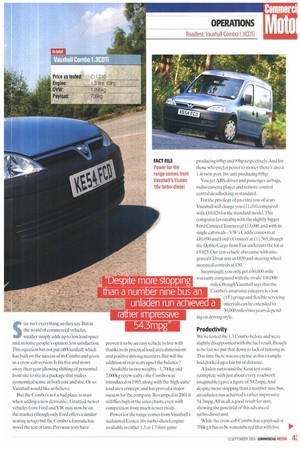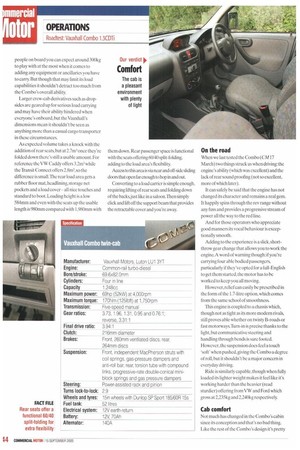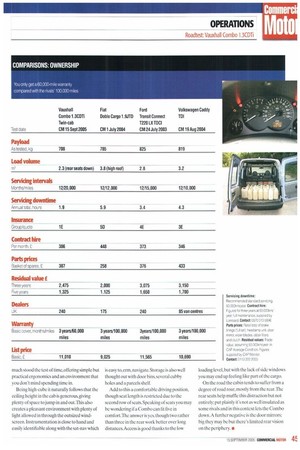LITTLE TREASURE?
Page 44

Page 45

Page 46

Page 47

If you've noticed an error in this article please click here to report it so we can fix it.
There are plenty of reasons to buy a crew-cab, but does one as small as Vauxhall's Combo justify its claims of versatility?
Size isn't everything, so they say. But the world of commercial vehicles, smaller simply adds up to less load space and, in some people's opinion, less satisfaction, This equation has not put off Vauxhall, which has built on the success of its Combo and given us a crew-cab version. It fits five and stows away their gear allowing shifting of personnel from site to site in a package that makes economical sense in both cost and size. Or so Vauxhall would like us believe. in But the Combo's not a bad place to start when adding a new derivative. Granted, newer vehicles from Ford and VW may now be on the market (though only Ford offers a similar seating setup) but the Combo's formula has stood the test of time. Previous tests have proven it to be an easy vehicle to live with thanks to its practical load area dimensions and positive driving manners. But will the addition of rear seats upset the balance?
Available in two weights— 1,700kg and 2,000kg (crew-cab) — the Combo was introduced in 1993, along with the 'high-cube' load area concept, and has proved a major success for the company. Revamped in 2001 it still flies high in the sales charts, even with competition from much newer rivals.
Power for the range comes from Vauxhall's acclaimed Ecotec 16v turbo-diesel engine available in either 1.3 or 1.7-litre guise producing 69hp and 99hp respectively. And for those who prefer petrol to money there's also a 1.4i twin-port 16v unit producing 89hp.
You get ABS, driver and passenger airbags, radio/cassette player and remote-control central deadlocking as standard.
For the privilege of an extra row of seats Vauxhall will charge you ,C11.010 compared with £10,020 for the standard model.This compares favourably with the slightly bigger Ford Connect Tourneo at .£13,000, and with its single cab rivals —VW's Caddy comes in at £10,690 and Ford's Connect at £11,565, though the Doblo Cargo from Fiat undercuts the lot at E.9,025. Our test vehicle also came with integrated CD/sat-nay at £850 and steering wheel mounted controls at £50.
Surprisingly, you only get a 60,000-mile warranty compared with the rivals' 100.000 miles, though Vauxhall says that the Combo's insurance category is a low (1F) group and flexible servicing intervals can be extended to 30,000 miles/two years depending on driving style.
Productivity We've tested the 1.3 Combo before and were slightly disappointed with the fuel result, though to be fair we put that down to lack of running in. This time there was no excuse as this example had clocked up a fair bit of distance.
A laden run round the Kent test route (complete with just about every roadwork imaginable) gave a figure of 50.2mpg. And despite more stopping than a number nine bus, an unladen run achieved a rather impressive 54.3mpg. All in all, a good result for sure, showing the potential of this advanced turbo-diesel unit.
While the crew-cab Combo has a payload of 708kg it has to be remembered that with five people on board you can expect around 300kg to play with at the most when it comes to adding any equipment or ancillaries you have to carry. But though that may limit its load capabilities it shouldn't detract too much from the Combo's overall ability.
Larger crew-cab derivatives such as dropsides are geared up for serious load carrying and may have their ability hindered when everyone's onboard, but the Vauxhall's dimensions mean it shouldn't be seen as anything more than a casual cargo transporter in these circumstances.
As expected volume takes a knock with the addition of rear seats, but at 2.7m3 once they're folded down there's still a usable amount. For reference the VW Caddy offers 3.2m3 while the Transit Connect offers 2.8m3, so the difference is small.The rear load area gets a rubber floor mat, headlining, storage net pockets and a load cover — all nice touches and standard to boot. Loading height is a low 584mm and even with the seats up the usable length is 980min compared with 1,980mm with them down. Rear passenger space is functional with the seats offering 60140 split-folding, adding to the load area's flexibility.
Access to this area is via near and off-side sliding doors that open far enough to hop in and out Converting to a load carrier is simple enough, requiring lifting of rear seats and folding down of the backs, just like in a saloon.11ien simply click and lift off the support beam that provides the retractable cover and you're away. On the road When we last tested the Combo (CM 17 March) two things struck us when driving: the engine's ability (which was excellent) and the lack of rear sound proofing (not so excellent, more of which later).
It can safely be said that the engine has not changed its character and remains a real gem. It happily spins through the rev range without any fuss and provides a progressive stream of power all the way to the red line.
And for those operators who appreciate good manners its vocal behaviour is exceptionally smooth.
Adding to the experience is a slick,shortthrow gear change that allows you to work the engine. A word of warning though:if you're carrying four able bodied passengers, particularly if they've opted for a full-English to get them started, the motor has to be worked to keep you all moving.
However, relief can easily be prescribed in the form of the 1.7-litre option,which comes from the same school of smoothness.
This engine is coupled to a chassis which, though not as tight as its more modern rivals, still proves able whether on twisty 13-roads or fast motorways.Turn-in is precise thanks to the light, but communicative steering and handling through bends is sure footed. However, the suspension does feel a touch 'soft when pushed, giving the Combo a degree of roll, but it shouldn't be a major concern in everyday driving.
Ride is similarly capable, though when fully loaded its lighter weight makes it feel like it's working harder than the heavier (read sturdier) offering from VW and Ford which gross at 2,235 kg and 2,240kg respectively Cab comfort Not much has changed in the Combo's cabin since its conception and that's no bad thing. Like the rest of the Combo's design it's pretty much stood the test of time, offering simple but practical ergonomics and an environment that you don't mind spending time in.
Being high-cube it naturally follows that the ceiling height in the cab is generous, giving plenty of space to jump in and out.This also creates a pleasant environment with plenty of light allowed in through the outsized windscreen. Instrumentation is close to hand and easily identifiable along with the sat-nay which is easy to, erm, navigate. Storage is also well thought out with door bins, several cubby holes and a parcels shelf.
Add to this a comfortable driving position, though seat length is restricted due to the second row of seats. Speaking of seats you may be wondering if a Combo can fit five in comfort.The answer is yes, though two rather than three in the rear work better over long distances. Access is good thanks to the low loading level, but with the lack of side windows you may end up feeling like part of the cargo.
On the road the cabin tends to suffer from a degree of road roar, mostly from the rear.The rear seats help muffle this distraction but not entirely; put plainly it's not as well insulated as some rivals and in this context lets the Combo clown.A further negative is the door mirrors: big they may be but there's limited rear vision on the periphery. •






































































































































































































